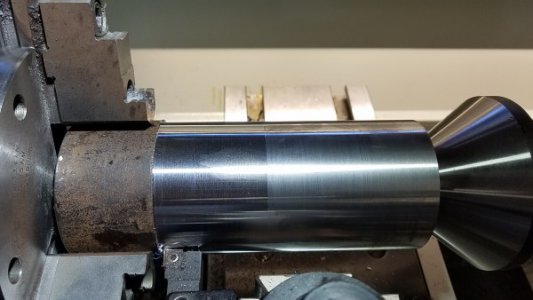- Joined
- Jan 22, 2017
- Messages
- 90
I don't know a great deal about the metal on my shelves: where I've been able to identify it, I've written on it but a lot of it is fairly anonymous. The colours that are sometimes applied to the ends of the bars don't really help: different manufacturers seem to use different colour codes.
Anyway, I need a short bar with an M14 thread on the end, so I picked up one of the anonymous rounds and popped it into my Myford. It's a small lathe with a maximum speed of about 500 rpm.
I have some of those cheap cutting tools with a piece of carbide brazed on to the end. Since they need using up I thought I'd use one to get the work-piece down to the nominal diameter. It might save using an insert for an indexed tool.
Well, the facing cut was really juddery even with very light cuts. I checked the tool height several times and made sure that the little lathe was running at top speed.
The first HSS centre drill snapped off. The second one made a hole, eventually, after I'd re-faced the work. The steel seemed to be very tough.
Now, turning with a live centre, there was less chatter but the finish was dreadful, rough as a bear's backside. I tried taking cuts of .001" but the finish still looked awful. Then, I inadvertently turned my cross-slide too far, about .005" - and I got the most incredible finish. It looks absolutely beautiful. I tried again at .002" - rubbish - and then .005" - perfection again.
I guess (I don't know) from the bright appearance of the work, now that it is cleaned up, that I'm dealing with something like chromoly steel which (I've heard) is not the easiest material to machine. Why the heavier cut gave better results baffles me. All I can think is that with very light cuts the tool can skite around on the surface but the slightly heavier cuts are somehow more rigid. I'm speculating.
Can anyone explain what I've encountered? Apart from my (random) choice of steel, am I doing something obviously wrong?
I wish I could a get a finish like this every time!
Kind wishes,
Nick
Anyway, I need a short bar with an M14 thread on the end, so I picked up one of the anonymous rounds and popped it into my Myford. It's a small lathe with a maximum speed of about 500 rpm.
I have some of those cheap cutting tools with a piece of carbide brazed on to the end. Since they need using up I thought I'd use one to get the work-piece down to the nominal diameter. It might save using an insert for an indexed tool.
Well, the facing cut was really juddery even with very light cuts. I checked the tool height several times and made sure that the little lathe was running at top speed.
The first HSS centre drill snapped off. The second one made a hole, eventually, after I'd re-faced the work. The steel seemed to be very tough.
Now, turning with a live centre, there was less chatter but the finish was dreadful, rough as a bear's backside. I tried taking cuts of .001" but the finish still looked awful. Then, I inadvertently turned my cross-slide too far, about .005" - and I got the most incredible finish. It looks absolutely beautiful. I tried again at .002" - rubbish - and then .005" - perfection again.
I guess (I don't know) from the bright appearance of the work, now that it is cleaned up, that I'm dealing with something like chromoly steel which (I've heard) is not the easiest material to machine. Why the heavier cut gave better results baffles me. All I can think is that with very light cuts the tool can skite around on the surface but the slightly heavier cuts are somehow more rigid. I'm speculating.
Can anyone explain what I've encountered? Apart from my (random) choice of steel, am I doing something obviously wrong?
I wish I could a get a finish like this every time!
Kind wishes,
Nick


